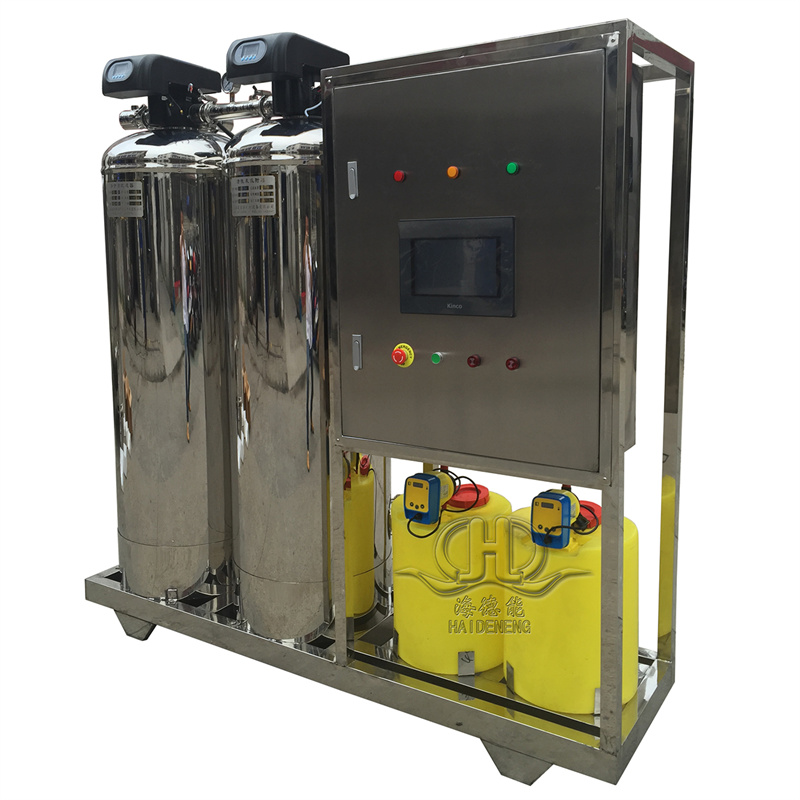Automatic Reverse Osmosis Purification System for Reducing Salinity and Filtering Impurities in Water
Product description
System composition:
Preprocessing unit: usually includes multi-media filters, such as quartz sand, anthracite and other filtering media, used to remove suspended solids, colloids and other large particle impurities in water; Activated carbon filter can effectively adsorb residual chlorine, organic matter, odors, etc. in water; Softeners (such as ion exchange resin softeners) can remove calcium and magnesium ions from water, reduce water hardness, and prevent scaling of reverse osmosis membranes.
Reverse osmosis unit: It is the core part of the system, consisting of reverse osmosis membrane components, high-pressure pumps, and pressure vessels. The high-pressure pump provides the required pressure for water to pass through the reverse osmosis membrane, which has extremely high filtration accuracy (about 0.0001 microns) and can intercept impurities such as salt, bacteria, viruses, heavy metal ions, and most organic matter in water, allowing water molecules to pass through the membrane and obtain purified water.
Control system: adopting automation control technology, such as programmable logic controller (PLC) and human-machine interface (HMI). PLC can achieve automatic start stop, flushing, dosing and other operations of equipment, and monitor water quality parameters (such as conductivity, turbidity, etc.) and equipment operating parameters (such as pressure, flow, etc.) in real time. HMI facilitates operators to intuitively understand the operating status of equipment, set parameters, and diagnose faults.
Post processing unit: may include sterilization and disinfection devices, such as ultraviolet sterilizers or ozone generators, to kill residual bacteria and microorganisms in water and ensure that water quality meets hygiene standards; There may also be water quality regulation equipment, such as pH adjustment devices, to adjust the acidity and alkalinity of purified water to an appropriate range.
working principle:
The raw water first goes through a pretreatment unit to remove larger particle impurities, residual chlorine, organic matter, and reduce hardness, so that the water meets the inlet requirements of the reverse osmosis membrane. The pre treated water enters the reverse osmosis unit, and under the action of the high-pressure pump, water molecules pass through the reverse osmosis membrane, while salt and other impurities are intercepted. The produced water enters the post-treatment unit for further purification, while the concentrated water is discharged or recycled for treatment. The control system automatically adjusts the operation of the equipment according to the set parameters to ensure stable and efficient operation of the system.
Advantages:
Efficient desalination and impurity removal: It can effectively reduce the salt content in water, remove various impurities, produce high-quality water, and meet the strict requirements of different industries for high-quality water, such as electronics, pharmaceuticals, chemical industry, etc.
High degree of automation: reduces manual operation, improves the stability and reliability of equipment operation, reduces labor intensity and operating costs.
Stable and reliable operation: Using high-quality membrane components and accessories, it has the advantages of strong anti pollution ability and long service life. At the same time, the control system can monitor and adjust equipment operating parameters in real time, and promptly detect and handle faults.
Strong adaptability: It can be flexibly configured and adjusted according to different raw water quality and water requirements, adapting to the purification treatment of multiple water sources.
Application areas:
Industrial production: Process water used in industries such as electronic chip manufacturing, pharmaceuticals, chemical raw material production, food and beverage processing, providing high-purity water for the production process.
Drinking water treatment: suitable for purifying drinking water in urban, rural, island and other areas, as well as supplying direct drinking water to schools, hospitals, office buildings and other places.
Desalination of seawater: It can convert seawater into drinkable and usable fresh water, solving the problem of water scarcity in coastal areas and islands.
Wastewater treatment and reuse: Deeply treat industrial wastewater and domestic sewage to meet reuse standards and achieve the recycling of water resources.











